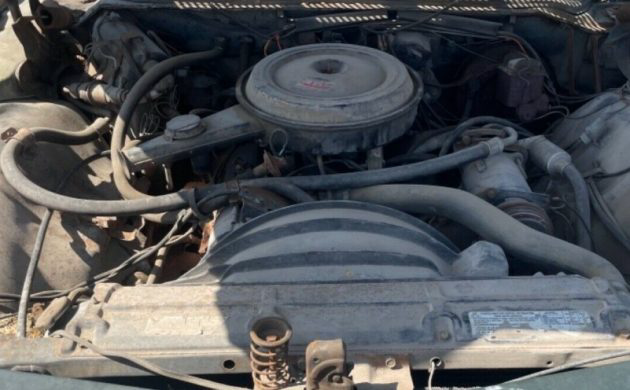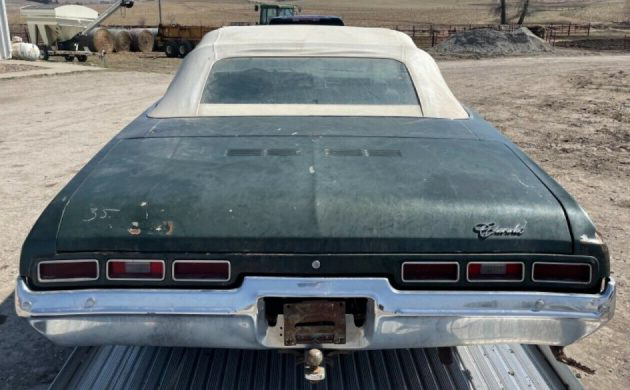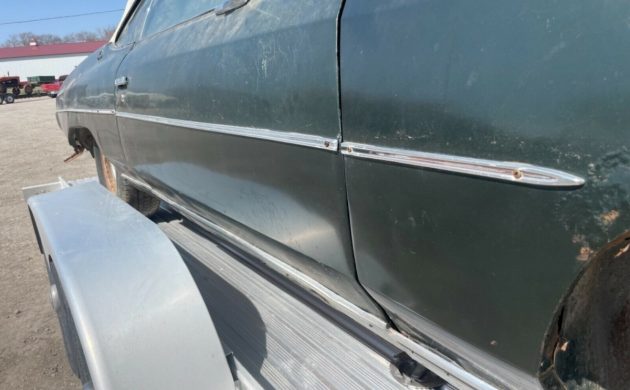Chevrolet’s tagline for 1971 was, “You’ve changed, we’ve changed“. Really? Sounds like some Madison Avenue horse hockey to me. Yeah, they changed by bloating up the B-body (Caprice, Impala, BelAir, Biscayne) bestowing Cadillacesque lines and size upon their best-selling series and there were other changes brought about too. The result? Chevrolet sold a lot fewer full-size cars in ’71 than it had the previous year. As to the why let’s take a look and see if we can determine the real reason. This Impala drop-top is located in Carlisle, Iowa and is available, here on eBay for a current bid of $17,800 with 46 bids tendered so far. Thanks to T.J. for this discovery!
The ’70 B-body was the end of the run for a very successful series that started in ’65 while the ’71 version marked the beginning of a generation that lasted through 1976. Total ’70 B-body production was about 825K units while ’71 saw a considerably more conservative 581K copies assembled. As for the convertible, ’71 was a nadir (unless you consider ’73 when none were built – the convertible had moved to the Caprice model) with only 4,576 examples seeing the light of day. The ’70 convertible volume was 9,562 and then things improved over the ’71 number, in ’72, yielding 6,572 ragtops. What happened? Well, ’70 was a recession year but that doesn’t really explain the almost 30% drop in total volume between the two years. There was a sizable GM labor strike that occurred between September and November of ’70, right at the beginning of the ’71 model year, and that’s more than likely the culprit for the abbreviated production volume.
Besides the big “upsizing” in ’71, there was a “downsizing” in the power department thanks to a change (those pesky changes again), the result of Federal law telling auto manufacturers that they were going to have to make changes. Thanks to the recently passed Clean Air Act, GM CEO, Ed Cole made a 1970 proclamation that all ’71 GM vehicles had to be capable of operating on low lead/no lead fuel for the ’71 model year. That order lead to reduced engine compression ratios and thusly, less power. The seller of this convertible identifies a 350 V8 engine as being the power source so that would indicate a standard 245 gross HP (250 in ’70), 350 CI V8 is under that Great Plaines sized hood. There was also a 270 gross HP version of the 350 available at mid-model year, but cars so equipped wore a fender badge and our subject car is not so adorned. The seller states, “Engine compartment is all original and I don’t see anything major missing” but makes no mention of operating capability. Being a barn find, assume this is a non-runner.
Another change for ’71 was a power ventilation system that kept the passenger compartment fan operating at all run times and pushed air through the trunk and then exhausted up through vents placed on the top of the trunk lid. The justification seemed fuzzy compared to ventilation systems in prior years. I suppose if you dropped your White Owl under the seat and forgot about it (and it didn’t engulf the car in flames), it might have made sense, but beyond that, its value seemed minimal. I remember owners complaining about a “drafty” interior with the fan always in operating mode.
Finished in what looks like Antique Green, the body has issues as the seller advises, “Car has rust. I would replace (the) front fenders, lower quarters and trunk pan the rest can be fixed“. The underside and floors are listed as “good” as is the top and its folding mechanism which works as it should.
We have more “goods”, at least considering its age we are told, inside. The images aren’t very telling though there is a noted rip in the black vinyl driver’s side seat back and the dash pad appears to be suffering from the same fate. That said, and based on the limited pictorial, the environment looks OK and doesn’t seem to have been too taxed by a lot of top-down time.
Back in the mid-late ’90s, I was in the market for a Chevy convertible and I found a ’71 dark blue, big-block powered example in Orlando. I hadn’t considered a ’71-’75 B-body convertible but was intrigued – the car looked a lot better than I recalled convertibles of that generation. I ultimately bought a ’66, which was more preferred, but I wondered for a while who picked up that ’71 – whoever it was got themselves a very nice example. Considering what this car is, and what it needs, the current bid seems high but old car values right now, like pretty much everything else, are all out of wack. What do you think, priced right, or not quite?









Bidding is now at $21,000 and I feel like
I just awoke from a coma & it’s now 2069.
Please explain why this is happening?
Future Donk Master bidding war. That is whats happening.
I have to agree with you, normadesmond, I’m somewhat amazed by the high price, too. “Car has rust. I would replace (the) front fenders, lower quarters and trunk pan the rest can be fixed.” The rear passenger side lower quarter panel is rotted out and I wonder how much rust is hidden under all the rocker moldings. This car obviously needs major rust work. The mechanicals need at least significant brake work after sitting for 25 years and probably a lot of work needs to be done to the fuel system. My guess is that this is a high mileage car so maybe some front-end work will be needed and who knows what the auto trans may need? The A/C is probably shot, it’s missing trim, it needs a dash pad, front and back bumpers are bent and you have to add new tires to the mix and who know what else it needs.
At this point it’s bid up to $21,000; am I missing something here or are we looking at some wildly enthusiastic shill bidding?
Has to be shill bidding FordGuy1972, no person in their right mind would pay half that for that car in its present condition. I wouldn’t give him more than 5K.
These things are awfully big. If I was looking for something from this era, I would go with a 1970.
IMO, these monsters as well as the heavy ’70s colonaides should not have been built – worse yet when they later have 5 mph bumpers front & back.
I had one of these in college. It’s a rolling party barge. A friend of mine had the same car with a hardtop. He claimed he could fit 13 people and a half keg of beer in it. That claim has been verified. I have been looking for one to relive my misspent youth but came to the conclusion that it wasn’t worth it. There’s another 71 on on eBay missing the top and bidding has surpassed $40k with 6 days to go. I bought a Porsche instead.
I bought a 1971 Impala hardtop in 1984 for $600, I loved it. I’d cruise it everywhere in Los Angeles until my brother borrowed it and totaled it. To this day, he has not paid me. Don’t ever let siblings borrow nothing.
This is bizarro world! Lol! $27,600 with 2 days left? Good grief. I guess this is a good candidate to paint red and tear through Las Vegas like Hunter S. Thompson! (in the movie ‘Fear and Loathing in Las Vegas’)
I learned to drive in a ’71 Kingswood Estate wagon so I know this car’s size. The price is way too high with the rust seen and what can’t be seen. Everything is going to need attention, yeah, that too. And as far as the rust, could be why the fender skirts aren’t in place
Sold for $51,400! What in the world am I missing about the value of a plain-Jane ’71 Impala drop-top?!
You aren’t missing a thing trav66, beauty is definitely in the eye of the beholder, but some of them have more money than sense!
Apparently it was shill bidding, John. The seller now has it relisted as a BIN price of $37,500 or make offer and added that a $500 deposit is required. There’s also a blue one listed on eBay that runs/drives but needs some work at $45,000 with 7 hours to go. I guess the low production #’s explain the astronomical prices of these. Wish I knew that 30 years ago! https://www.ebay.com/itm/363808188163?hash=item54b4a86703:g:1fQAAOSwA99iXzFd
I know that rarity is also a factor, which is why my 70 SS Monte is so highly-priced but when an old Impala ragtop with a base 350 is selling for more than a decent corvette, I guess I just don’t see it.